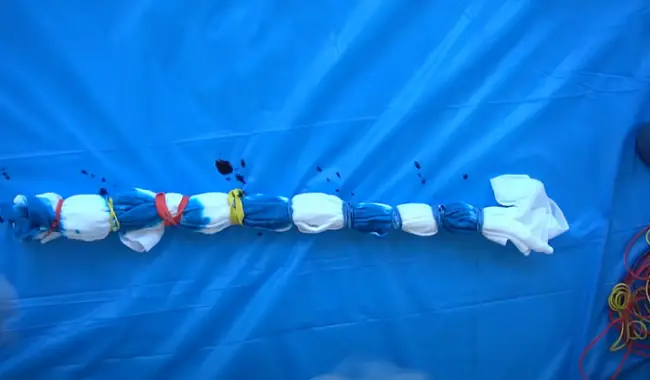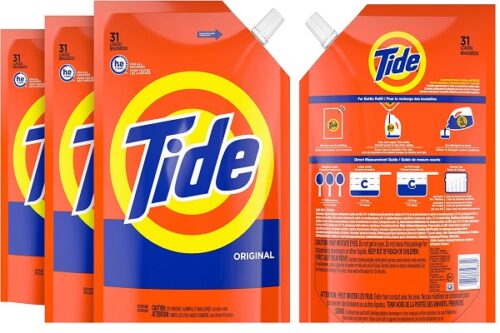
This is the common question of my visitors how are like tie dye? You see the image on top is the best anti-staining or anti-bleeding tie-dye technique.
Tie-dyeing is a fun and colorful way to express your creativity on fabric. However, one common challenge faced by tie-dye enthusiasts is preventing the dyes from bleeding into white areas of the design. In this guide, we will provide you with essential tips and steps to help you keep your tie dye vibrant and prevent bleeding.
Tie-dye bleeding into white areas is a common problem in tie-dye procedures. We can solve this staining by taking some technical steps:
- Need to wash properly with detergent: For removing softener and impurities.
- Wash in cold water: To remove impurities and sizing materials and oil and waxes.
- Avoid hot water: Must not use a hot wash on any steps of the tie-dye procedure.
- Check the even absorbency: For even dye pic up%.
- Use Heavy GSM compact fabric: That means tightly knitted or woven fabric has the capability of low bleeding.
- Pre-testing: Test a small area, is it bleeding or not. If it bleed then you have to follow the previous instruction again.
- Check the tie of the fabric: Tie the fabric tightly with a rubber band or with anything.
- Use High-quality dyes: Use branded dyes because lower-quality dyes have low fixing properties.
- Use fixative: Use some ready-made fixative for high-fixing dyes on fabric. You can also use soda after tie dye for more fixing. Soda is a high-quality fixing agent.
- Dry on air: After tie dye drying the fabric on air is a good practice.
Certainly! Let’s delve deeper into each step of the tie-dyeing process:
1. Proper Washing with Detergent:
Thoroughly washing the fabric with detergent is a critical initial step. This process serves to strip away any residual softeners and impurities that may have accumulated during the manufacturing or storage of the fabric. By doing so, it creates a clean canvas for the dye to adhere to, ensuring a vibrant and long-lasting result.
2. Cold Water Wash:
Washing the fabric in cold water serves a dual purpose. Firstly, it aids in removing impurities such as dust, dirt, and sizing materials. Sizing materials are often applied to fabrics during production to enhance their stability, and washing them away is crucial for optimal dye absorption. Additionally, cold water helps in removing any traces of oil or wax that might be present on the fabric’s surface. This step sets the foundation for an even and thorough dyeing process.
3. Avoid Hot Water:
Using hot water in any phase of the tie-dye process should be strictly avoided. Hot water can cause the fabric’s fibers to expand and open up, potentially leading to bleeding or uneven color absorption. Sticking to cold water throughout ensures a controlled and consistent dyeing experience.
4. Ensure Even Absorbency:
Ensuring that the fabric exhibits even absorbency is a key factor in achieving a uniform and aesthetically pleasing tie-dye pattern. This involves confirming that the fabric has absorbed the water and is ready to receive the dye. It prevents patchy or blotchy coloring, resulting in a more visually appealing final product.
5. Use Heavy GSM Compact Fabric:
Opting for a fabric with a heavy GSM, indicating a densely woven or knitted material is advantageous in tie-dyeing. Such fabrics have a lower tendency to bleed, meaning the colors are less likely to spread or mix during the dyeing process. This characteristic ensures that the final result will maintain the integrity of the chosen pattern.
6. Pre-testing for Bleeding:
Before committing to the full dyeing process, it’s prudent to conduct a small-scale test to determine if the fabric is prone to bleeding. Bleeding occurs when the dye spreads uncontrollably, potentially muddling the intended design. Identifying and addressing this issue beforehand saves both time and resources, ensuring a smoother tie-dyeing experience.
7. Secure Fabric Ties:
Achieving distinctive tie-dye patterns relies heavily on securely tying the fabric. This step is fundamental in creating the desired designs, as it dictates which areas will absorb dye and which will remain untouched. Using rubber bands or other suitable materials, tightly securing the fabric ensures crisp and defined patterns.
8. Use High-quality Dyes:
Investing in high-quality dyes is a crucial aspect of successful tie-dyeing. Lower-quality dyes often have weaker fixing properties, which can lead to colors fading over time or washing out prematurely. By opting for reputable, branded dyes, you ensure that the vibrant hues you’ve chosen will endure.
- Artistic Adventures Aplenty - Our Tie Dye Kit opens the door to artistic exploration. With...
- Endless Wardrobe Transformation - With our Tie Dye Kit, your wardrobe becomes a canvas for...
- Revive and Renew Your World - RIT Dye is your go-to for revitalizing faded fabrics....
- Crafting Freedom and Versatility - RIT Dye isn't just for clothing; it's your versatile...
- Customizable Color Choice - Explore a spectrum of stunning shades with the range of RIT...
9. Apply Fixatives:
Applying a fixative is a recommended step, especially for dyes that require strong adherence to the fabric. Fixatives enhance the dye’s colorfastness, helping it withstand multiple washes without significant fading. Ready-made fixatives provide a reliable solution, or you can opt to use soda, a high-quality fixing agent, after the tie-dyeing process for added durability.
10. Air Dry the Fabric:
Allowing the tie-dyed fabric to air dry is a prudent practice. Air drying provides a gentle, natural setting process for the dye, helping to ensure that the colors set properly. This step contributes to the longevity of the tie-dye, preventing premature fading and preserving the vibrancy of the chosen hues.
By meticulously following these steps, you’ll significantly increase the likelihood of achieving vibrant, long-lasting tie-dye results. Each element plays a crucial role in the overall outcome, ensuring a visually striking and durable final product.
By following these tips and steps, you can enjoy vibrant and well-defined tie-dye designs while keeping the colors from bleeding into white areas of your fabric. Remember to properly wash your fabric before dyeing, choose heavy GSM compact fabrics when possible, pre-test for potential bleeding, and use high-quality dyes and fixatives to enhance color fixation. With these precautions and techniques, you can achieve beautiful and long-lasting tie-dye creations!
You may read my other topics like this:
You can also visit:


